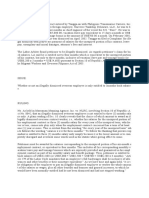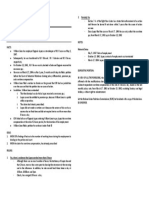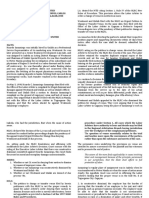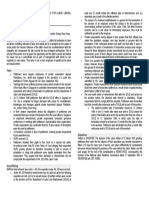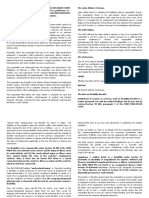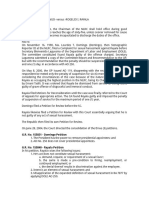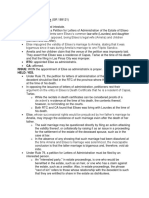0 ratings0% found this document useful (0 votes)
54 viewsMallari - PT&T To Czarina
Mallari - PT&T To Czarina
Uploaded by
Justine M.Grace was hired by PT&T but dismissed after they discovered she was married, which violated their policy. The Court found the policy discriminated against women and was illegal. While Grace misrepresented her status, it was not done in bad faith but to keep her job. PT&T's justification for dismissal due to dishonesty was unreasonable. Villas was granted study leave from her teaching job but dismissed for allegedly violating leave terms. However, she was engaged in permitted part-time work and her actions did not warrant dismissal. Ramil's dismissal from his job for alleged loss of trust due to a form issue was not properly substantiated by his employer. Dismissals must satisfy both substantive and procedural requirements to be
Copyright:
© All Rights Reserved
Available Formats
Download as DOCX, PDF, TXT or read online from Scribd
Mallari - PT&T To Czarina
Mallari - PT&T To Czarina
Uploaded by
Justine M.0 ratings0% found this document useful (0 votes)
54 views6 pagesGrace was hired by PT&T but dismissed after they discovered she was married, which violated their policy. The Court found the policy discriminated against women and was illegal. While Grace misrepresented her status, it was not done in bad faith but to keep her job. PT&T's justification for dismissal due to dishonesty was unreasonable. Villas was granted study leave from her teaching job but dismissed for allegedly violating leave terms. However, she was engaged in permitted part-time work and her actions did not warrant dismissal. Ramil's dismissal from his job for alleged loss of trust due to a form issue was not properly substantiated by his employer. Dismissals must satisfy both substantive and procedural requirements to be
Original Description:
labor
Original Title
Mallari_PT&T to Czarina
Copyright
© © All Rights Reserved
Available Formats
DOCX, PDF, TXT or read online from Scribd
Share this document
Did you find this document useful?
Is this content inappropriate?
Grace was hired by PT&T but dismissed after they discovered she was married, which violated their policy. The Court found the policy discriminated against women and was illegal. While Grace misrepresented her status, it was not done in bad faith but to keep her job. PT&T's justification for dismissal due to dishonesty was unreasonable. Villas was granted study leave from her teaching job but dismissed for allegedly violating leave terms. However, she was engaged in permitted part-time work and her actions did not warrant dismissal. Ramil's dismissal from his job for alleged loss of trust due to a form issue was not properly substantiated by his employer. Dismissals must satisfy both substantive and procedural requirements to be
Copyright:
© All Rights Reserved
Available Formats
Download as DOCX, PDF, TXT or read online from Scribd
Download as docx, pdf, or txt
0 ratings0% found this document useful (0 votes)
54 views6 pagesMallari - PT&T To Czarina
Mallari - PT&T To Czarina
Uploaded by
Justine M.Grace was hired by PT&T but dismissed after they discovered she was married, which violated their policy. The Court found the policy discriminated against women and was illegal. While Grace misrepresented her status, it was not done in bad faith but to keep her job. PT&T's justification for dismissal due to dishonesty was unreasonable. Villas was granted study leave from her teaching job but dismissed for allegedly violating leave terms. However, she was engaged in permitted part-time work and her actions did not warrant dismissal. Ramil's dismissal from his job for alleged loss of trust due to a form issue was not properly substantiated by his employer. Dismissals must satisfy both substantive and procedural requirements to be
Copyright:
© All Rights Reserved
Available Formats
Download as DOCX, PDF, TXT or read online from Scribd
Download as docx, pdf, or txt
You are on page 1of 6
PT&T V.
NLRC (May 23, 1997)
FACTS
Grace de Guzman was hired by petitioner Philippine Telegraph and Telephone
Company as a reliever when another employee went on maternity leave. Her
employment was to be terminated after the agreed period.
Grace was then hired by PT&T as a probationary employee. In her job
application, she indicated her civil status as single although she had contracted
marriage a few months earlier. She also made the same representation in the
previous reliever agreements she had with PT&T.
PT&T had a policy of not accepting married women for employment. When it
found out about Grace’s misrepresentations, they required her to explain. Grace
replied that she was not aware of PT&T’s policy regarding married women at the
time, and that all along she had not deliberately hidden her true civil status.
PT&T dismissed Grace from the company. Grace then filed a complaint for illegal
dismissal before the Regional Arbitration Branch of the NLRC in Baguio City.
o The Labor Arbiter declared that Grace, who had already gained the status
of a regular employee, was illegally dismissed.
o It firmly expressed view that the ground relied upon by petitioner in
dismissing private respondent was clearly insufficient, and that it was
apparent that she had been discriminated against on account of her
having contracted marriage in violation of company rules.
The NLRC affirmed the LA.
ISSUE: WON Grace was illegally dismissed due to PT&T’s illegal policy.
HELD: YES.
In the case at bar, petitioner’s policy of not accepting or considering as
disqualified from work any woman worker who contracts marriage runs afoul of
the test of, and the right against, discrimination, afforded all women workers by
our labor laws and by no less than the Constitution.
Grace’s misrepresentation cannot be considered as willful or in bad faith as she
was moved to act the way she did mainly because she wanted to retain a
permanent job in a stable company.
o While loss of confidence is a just cause for termination of employment, it
should not be simulated. It must rest on an actual breach of duty
committed by the employee and not on the employers caprices.
Furthermore, it should never be used as a subterfuge for causes which
are improper, illegal, or unjustified.
PT&T argues that they dismissed Grace not because of her civil status, but
because of her dishonesty. The Court found this unreasonable as it suggests that
if the employee confesses their marriage, there will be no sanctions, but if they
hide the same, they will be dismissed.
Art. 136 of the Labor Code states that “it shall be unlawful for an employer to
require as a condition of employment or continuation of employment that a
woman shall not get married...”
It is not relevant that the rule is not directed against all women but just against
married women. And, where the employer discriminates against married women,
but not against married men, the variable is sex and the discrimination is
unlawful.
PT&T’s policy assaults good morals and public policy, tending as it does to
deprive a woman of the freedom to choose her status, a privilege that by all
accounts inheres in the individual as an intangible and inalienable right.
The Civil Code provisions on the contract of labor state that the relations
between the parties, that is, of capital and labor, are not merely contractual,
impressed as they are with so much public interest that the same should yield to
the common good. It goes on to intone that neither capital nor labor should visit
acts of oppression against the other, nor impair the interest or convenience of the
public.
ART. 1702 CC in relation to ART. 4 LC
COLEGIO DE SAN JUAN DE LETRAN-CALAMBA V. VILLAS (March 26, 2003)
FACTS:
Belen Villas was employed by the petitioner as a high school teacher. She
requested and was granted a six-month study leave.
Villas intended to finish her masteral degree as the PWU in the first semster.
However, it did not push through so she took up an Old Testament course in a
school of religion and used her free time to sell insurance and cookware.
In the second semester, Villas passed 12 units of education subjects. She sent a
certification and a letter on why she took up an Old Testament course to
petitioner as an explanation to her study leave.
The President and Rector of the school, Fr. Mendez, wrote to Villas that since
she did not enroll during the first semester, she violated the conditions of her
study leave and that her reasons were unacceptable.
Villas filed a case for illegal dismissal. Voluntary Arbitrator Mayuga found that
she was illegally dismissed.
Petitioner appealed to the CA and was denied.
ISSUE: WON Villas was illegally dismissed.
HELD: YES.
Under the Labor Code, there are twin requirements to justify a valid dismissal
from employment: (a) the dismissal must be for any of the causes provided in
Article 282 of the Labor Code (substantive aspect) and (b) the employee must be
given an opportunity to be heard and to defend himself (procedural aspect).
o The employee must be given two written notices before she is terminated.
In this case, both requirements were not satisfied.
Villas cannot be charged with misconduct. Although she should have first
ascertained whether she was eligible to study at PWU before applying for a study
leave, such lapse was more of an error in judgment rather than an act of serious
misconduct.
Villas not violate the prohibition on engaging in employment outside the school
as specified in her study leave grant and as provided in the Faculty Manual.
o Once proven beyond reasonable doubt during the period of the approved
leave of absence that the faculty member shall engage himself in
employment outside the institution, the administration shall regard the
faculty member on leave resigned.
o The term “employment” is ambiguous. It can mean any work or service in
exchange for money, with or without an EE-ER relationship.
o It must be construed strictly against the petitioner. It is a settled rule that in
controversies between a laborer and his master, doubts reasonably
arising from the evidence, or in the interpretation of agreements and
writings should be resolved in the former’s favor.
Villas’ selling of insurance and cookware was not an “employment.” The
prohibition against outside employment was enacted to prevent the teacher from
using the study leave period for unsanctioned purposes since the School pays
the teacher while pursuing further studies. That rationale was not violated by
respondent for the reason that her part-time activity of selling insurance and
cookware could not have prevented her in any way from studying and, more
importantly, she was not being paid by the School while on leave.
CENTURY CANNING CORP. V. RAMIL (August 8, 2010)
FACTS:
Vicente Ramil was employed by the petitioner as a technical specialist. His job
included the preparation of purchase requisition (PR) forms and capital
expenditure (CAPEX) forms, as well as the coordination with the purchasing
department regarding technical inquiries on needed products and services of
petitioner's different departments.
Ramil prepared a CAPEX form for external fax modems and terminal server.
However, it did not have complete details and some of the required signatures.
The CAPEX was transferred to Purchasing Officer Paz, and she found that some
details were left blank, and that the genuineness of the signature of Vice
President Po was doubtful.
Ramil was asked to explain the events surrounding the incident. He was then
suspended, and eventually his services were terminated due to loss of trust and
confidence.
Ramil filed a complaint for illegal dismissal before the Labor Arbiter.
o The LA dismissed it.
Upon appeal to the NLRC, the LA ruling was reversed.
o Upon MR, the NLRC reversed itself and upheld the LA.
The CA found for Ramil.
Petitioner now insists that the mere existence of a basis for believing that
respondent employee has breached the trust and confidence of his employer
suffices for his dismissal.
ISSUE: WON the supposed loss of trust and confidence in Ramil was properly
substantiated.
HELD: NO.
Ramil argues that he merely received the CAPEX with VP Po’s signature already
on it after he endorsed the same to Marivic Villanueva for the signature.
o It may thus be correctly inferred that he was not the forger.
o If respondent was the one who forged the signature of Po in the CAPEX
form, there was no need for him to endorse the same to Villanueva and
transmit it the next day.
The burden of proving the validity of the termination of employment rests with the
employer. Failure to discharge this evidentiary burden would necessarily mean
that the dismissal was not justified and, therefore, illegal.
o In case of doubt, such cases should be resolved in favor of labor, pursuant
to the social justice policy of labor laws and the Constitution.
The information that the petitioner allegedly obtained from “persons concerned”
was not backed up by any affidavit or proof.
Petitioner based respondent's dismissal on its unsubstantiated suspicions and
conclusion that since respondent was the custodian and the one who prepared
the CAPEX forms, he had the motive to commit the forgery. However, as
correctly found by the NLRC in its original Decision, respondent would not be
benefited by the purchase of the subject equipment. The equipment would be for
the use of petitioner company.
ART. 19 CC
MATA V. AGRAVANTE (August 6, 2008)
FACTS:
Respondents were former security guards of the Bessang Pass Security Agency,
owned by Mata.
Respondents filed a complaint for non-payment of salaries/wages with the NLRC.
They also filed a complaint with the PNP for the investigation of Bessang and the
cancellation of its license to operate.
Mata filed an action for damages against respondents, averring that the latter’s
“campaign of hate and vilification” violated Arts. 19-21 of the Civil Code.
The TC found for Mata. The CA reversed the TC.
Petitioner claims that respondent were so driven by unrestrained hatred and
revenge that when they sent the complaint to 7 government agencies including
the DPWH, Mata’s biggest client, they intended to destroy her reputation and
business.
ISSUE: WOB respondents violated Arts. 19-21 of the CC.
HELD: NO.
Art. 19’s object is to set certain standards which must be observed not only in the
exercise of one's rights but also in the performance of one's duties (act with
justice, give everyone their due, honesty and good faith).
Art. 21 refers to acts contra bonos mores and has the following elements: (1) an
act which is legal; (2) but which is contrary to morals, good custom, public order
or public policy; and (3) is done with intent to injure.
The common element under Articles 19 and 21 is that the act complained of must
be intentional, and attended with malice or bad faith.
There was no malicious intent in the acts of respondents. They merely wanted to
call the attention of responsible government agencies in order to secure
appropriate action upon an erring private security agency and obtain redress for
their grievances.
Czarina Malvar v. Kraft Food Phils. (September 9, 2013)
FACTS:
Kraft Foods hired Malvar as its Corporate Planning Manager. She then gradually
rose from the ranks and became Vice President for Finance in the SEA Region of
Kraft’s mother company KFI.
The Chairman of the Board of KFI sent Malvar a memo to explain why no
administrative sanctions should be imposed on her for possible breach of trust
and confidence and for willful violation of company rules and regulations. Malvar
was suspended, and then ultimately dismissed.
Malvar filed a complaint for illegal dismissal with the NLRC
o The LA found for Malvar.
o The NLRC affirmed.
o The CA upheld.
Malvar moved for the execution of the judgement. The Research and
Computation Unit of the NLRC computed for the total monetary awards for the
judgement, which came to over P41 million.
o LA reduced it to P27M.
Malvar filed a second writ of execution, which was partially granted. Respondents
appealed to the CA, and the CA issued a TRO enjoining the implementation of
the NLRC decision.
Pending appeal, Malvar and the respondents entered into a Compromise
Agreement. Malvar then filed a Motion to Dismiss.
A Motion for Intervention to Protect Attorney’s Rights from The Law Firm of
Dasal, Llasos and Associates was filed, seeking Malvar and the respondents to
pay Intervenor’s contingent fees.
o However, Malvar unceremoniously terminated their services. The firm now
wants to recover full compensation from Malvar.
ISSUE: WON the intervenor was dismissed for justifiable cause.
HELD: NO.
The Court disapproves of the tendencies of clients compromising their cases
behind the backs of their attorneys for the purpose of unreasonably reducing or
completely setting to naught the stipulated contingent fees.
Although a client may dismiss her lawyer at any time, the dismissal must be for a
justifiable cause if a written contract between the lawyer and the client exists.
In the absence of the lawyer’s fault, consent or waiver, a client cannot deprive
the lawyer of his just fees already earned in the guise of a justifiable reason.
The stipulations of the written agreement between Malvar and the Intervenors,
not being contrary to law, morals, public policy, public order or good customs,
were valid and binding on her. They expressly gave rise to the right of the
Intervenor to demand compensation. In a word, she could not simply walk away
from her contractual obligations towards the Intervenor, for Article 1159 of the
Civil Code provides that obligations arising from contracts have the force of law
between the parties and should be complied with in good faith.
The respondents would be liable if they were shown to have connived with
Malvar in the execution of the compromise agreement, with the intention of
depriving the Intervenor of its attorney’s fees. Thereby, they would be solidarily
liable with her for the attorney’s fees as stipulated in the written agreement under
the theory that they unfairly and unjustly interfered with the Intervenor’s
professional relationship with Malvar.
You might also like
- Civil and Criminal ProcedureDocument132 pagesCivil and Criminal ProcedureRomsamBla100% (4)
- Michael ClaytonDocument128 pagesMichael ClaytonBhartiJakharNo ratings yet
- 140 PH Migrants Vs OwwaDocument14 pages140 PH Migrants Vs Owwaanapot14100% (1)
- TSRDungeons&DragonsBasic GazetteerTheMinrothadGuilds PDFDocument120 pagesTSRDungeons&DragonsBasic GazetteerTheMinrothadGuilds PDFLorenzo Sperzaga86% (7)
- Organic Chemistry: Orbitals HybridizationDocument21 pagesOrganic Chemistry: Orbitals HybridizationTalal Ahmed Awad MohammedNo ratings yet
- 15 - Tongco vs. VianzonDocument1 page15 - Tongco vs. VianzonRuth LumibaoNo ratings yet
- Cebu Marine Beach Resort Vs NLRC, YAMBAODocument3 pagesCebu Marine Beach Resort Vs NLRC, YAMBAOMaCai YambaoNo ratings yet
- Begino V ABS-CBN CorporationDocument2 pagesBegino V ABS-CBN CorporationMariano RentomesNo ratings yet
- 02.eagle Security Agency, Inc. vs. NLRC PDFDocument10 pages02.eagle Security Agency, Inc. vs. NLRC PDFAngelica AbalosNo ratings yet
- Philippine Spring Water V CADocument3 pagesPhilippine Spring Water V CAEdeline CosicolNo ratings yet
- 031 Phil Hoteliers V NUWHRAIN-APL-IUFDocument2 pages031 Phil Hoteliers V NUWHRAIN-APL-IUFkim_santos_20No ratings yet
- Phil. Duplicators v. NLRCDocument2 pagesPhil. Duplicators v. NLRCIldefonso HernaezNo ratings yet
- People v. GalloDocument1 pagePeople v. Gallomonica may ramosNo ratings yet
- 15 - PLDT v. PaguioDocument1 page15 - PLDT v. PaguioJohn PaumigNo ratings yet
- A Prime Security Services Inc. v. NLRC G.R. 107320 January 10 2000Document2 pagesA Prime Security Services Inc. v. NLRC G.R. 107320 January 10 2000MekiNo ratings yet
- People V OcimarDocument2 pagesPeople V OcimarLeo Angelo Menguito100% (1)
- Orient Insurance Vs RevillaDocument5 pagesOrient Insurance Vs RevillaJacinto Jr JameroNo ratings yet
- Tangga-An v. Philippine TransmarineDocument8 pagesTangga-An v. Philippine TransmarineEcxoj MortelNo ratings yet
- Peñaranda Vs BagangaDocument1 pagePeñaranda Vs BagangachugamiNo ratings yet
- 6 William Lines Inc V LopezDocument1 page6 William Lines Inc V LopezJonas TNo ratings yet
- Dealco Farms DigestDocument2 pagesDealco Farms DigestkarlonovNo ratings yet
- 05 Toyota Motors Phils Corp WA V Toyota MotorsDocument4 pages05 Toyota Motors Phils Corp WA V Toyota MotorsArtemisTzyNo ratings yet
- Elenita Dewara V Spouses LamelaDocument2 pagesElenita Dewara V Spouses LamelaIkangApostolNo ratings yet
- Cagatan Sugar Milling V Secretary of LaborDocument4 pagesCagatan Sugar Milling V Secretary of LaborDane Pauline AdoraNo ratings yet
- Case Digest PenarandaDocument20 pagesCase Digest PenarandaBrenPeñarandaNo ratings yet
- 40 David V Macasio (Streegan)Document2 pages40 David V Macasio (Streegan)Gia DimayugaNo ratings yet
- #7 Tabang Vs NLRC G.R. No. 121143, January 21, 1997 FactsDocument1 page#7 Tabang Vs NLRC G.R. No. 121143, January 21, 1997 FactsPNP MayoyaoNo ratings yet
- EVIDENCE US Vs Gordon NikkarDocument1 pageEVIDENCE US Vs Gordon NikkarCarmii HoNo ratings yet
- Far East Agricultural Supply Inc V LebatiqueDocument8 pagesFar East Agricultural Supply Inc V LebatiqueBonito BulanNo ratings yet
- Orient Insurance Company, Petitioner, E. P. REVILLA, Judge of First Instance of Manila, and TEAL MOTOR CO., INC., RDocument3 pagesOrient Insurance Company, Petitioner, E. P. REVILLA, Judge of First Instance of Manila, and TEAL MOTOR CO., INC., RIan SabsNo ratings yet
- David Versus Macasio DigestDocument2 pagesDavid Versus Macasio DigestLuz Celine CabadingNo ratings yet
- Cagampan Vs NLRCDocument1 pageCagampan Vs NLRCShally Lao-unNo ratings yet
- LaborDocument11 pagesLaborRafael AquinoNo ratings yet
- Standard Chatered Bank Employees Union (NUBE) vs. Hon. Nieves Confesor, June 16, 2004Document3 pagesStandard Chatered Bank Employees Union (NUBE) vs. Hon. Nieves Confesor, June 16, 2004Raje Paul ArtuzNo ratings yet
- G.R. No. 65377 - Molave Motor Sales, Inc. v. LaronDocument4 pagesG.R. No. 65377 - Molave Motor Sales, Inc. v. LaronElla CanuelNo ratings yet
- Coca-Cola vs. CBCPI UnionDocument2 pagesCoca-Cola vs. CBCPI UnionRobNo ratings yet
- Digest Technogas v. CA - Lex AnimoDocument5 pagesDigest Technogas v. CA - Lex AnimoRamil GarciaNo ratings yet
- Marticio Semblante and Dubrick Pilar Vs CA - GR No. 196426 - August 15, 2011Document4 pagesMarticio Semblante and Dubrick Pilar Vs CA - GR No. 196426 - August 15, 2011BerniceAnneAseñas-ElmacoNo ratings yet
- Trans Asia vs. NLRCDocument4 pagesTrans Asia vs. NLRCReyrhye RopaNo ratings yet
- Octaviano V NLRCDocument5 pagesOctaviano V NLRCAleine Leilanie OroNo ratings yet
- 101 Union of Filipro Employees Vs Vivar (Labor)Document1 page101 Union of Filipro Employees Vs Vivar (Labor)Kayelyn Lat100% (1)
- Westmont vs. SamaniegoDocument3 pagesWestmont vs. SamaniegoApple AbadillaNo ratings yet
- 06 Fuentes V NLRCDocument1 page06 Fuentes V NLRCPaolo Miguel ArqueroNo ratings yet
- Union of Filipro Employees VDocument10 pagesUnion of Filipro Employees Vmoron kaNo ratings yet
- 130.1 Manila Electric Co. v. QuisumbingDocument10 pages130.1 Manila Electric Co. v. QuisumbingClarence ProtacioNo ratings yet
- 03-King of Kings Transport, Inc. Vs Mamac - Case DigestDocument3 pages03-King of Kings Transport, Inc. Vs Mamac - Case DigestthelawanditscomplexitiesNo ratings yet
- Sy V CADocument6 pagesSy V CAHudson CeeNo ratings yet
- 7 9 DigestDocument7 pages7 9 DigestRaymarc Elizer AsuncionNo ratings yet
- Mercidar Fishing V NLRC DIGESTDocument1 pageMercidar Fishing V NLRC DIGESTᜇᜒᜀᜈ᜔ᜈ ᜋᜓᜈ᜔ᜆᜓᜌ100% (2)
- Virgen Shipping Corporation, Et Al. V. Jesus B. Barraquio 597 SCRA 411 (2009), SECOND DIVISION (Carpio Morales, J.)Document1 pageVirgen Shipping Corporation, Et Al. V. Jesus B. Barraquio 597 SCRA 411 (2009), SECOND DIVISION (Carpio Morales, J.)piptipaybNo ratings yet
- Songco vs. NLRCDocument8 pagesSongco vs. NLRCTia RicafortNo ratings yet
- MANILA PAVILION HOTEL Vs Delada DigestedDocument1 pageMANILA PAVILION HOTEL Vs Delada Digestedgregoriomanueldon.patrocinioNo ratings yet
- Facto Partnership Among Them Was Created, and ThatDocument4 pagesFacto Partnership Among Them Was Created, and ThatkaiNo ratings yet
- Petitioners: Raul G. Locsin and Eddie B. Tomaquin Respondent: Philippine Long Distance Telephone Company DoctrineDocument2 pagesPetitioners: Raul G. Locsin and Eddie B. Tomaquin Respondent: Philippine Long Distance Telephone Company DoctrineKaren Selina AquinoNo ratings yet
- (Article 282) 15. Domingo (V) RayalaDocument4 pages(Article 282) 15. Domingo (V) RayalaAnonymous wbEpfdMNo ratings yet
- 072-Lopez, Jr. v. NLRC G.R. No. 109166 July 6, 1995Document5 pages072-Lopez, Jr. v. NLRC G.R. No. 109166 July 6, 1995Jopan SJNo ratings yet
- G.R. No. 131903Document9 pagesG.R. No. 131903Sirch RudolfNo ratings yet
- Palacol V CallejaDocument2 pagesPalacol V CallejaMiguel CastricionesNo ratings yet
- 276 G&M Phil v. BatomalaqueDocument13 pages276 G&M Phil v. Batomalaquedos2reqjNo ratings yet
- 26 Reyes Vs CADocument22 pages26 Reyes Vs CALanz OlivesNo ratings yet
- Philippine Telegram and Telephony vs. NLRCDocument3 pagesPhilippine Telegram and Telephony vs. NLRCCherith Inna MonteroNo ratings yet
- Consti Law DigestedDocument25 pagesConsti Law DigestedxylentknightNo ratings yet
- Labor Digest Special Group To Pre-EmployDocument50 pagesLabor Digest Special Group To Pre-EmployKaren Ryl Lozada BritoNo ratings yet
- Sample - Research PaperDocument13 pagesSample - Research PaperJustine M.No ratings yet
- Mallari - BolinaoDocument5 pagesMallari - BolinaoJustine M.No ratings yet
- REBUSQUILLO V. SPS. GALVEZ (June 4, 2014) FactsDocument5 pagesREBUSQUILLO V. SPS. GALVEZ (June 4, 2014) FactsJustine M.No ratings yet
- Mallari Ramirez DBPDocument4 pagesMallari Ramirez DBPJustine M.No ratings yet
- Garcia-Quiazon v. Belen (GR 189121) FactsDocument2 pagesGarcia-Quiazon v. Belen (GR 189121) FactsJustine M.No ratings yet
- LIU V. LOY (September 13, 2004) FactsDocument1 pageLIU V. LOY (September 13, 2004) FactsJustine M.No ratings yet
- Labor Page 6-7Document125 pagesLabor Page 6-7Justine M.No ratings yet
- Succession MidtermsDocument112 pagesSuccession MidtermsJustine M.No ratings yet
- 2nd Batch - MallariDocument1 page2nd Batch - MallariJustine M.No ratings yet
- Labor Page 4-5Document220 pagesLabor Page 4-5Justine M.No ratings yet
- Torts 1 30Document126 pagesTorts 1 30Justine M.No ratings yet
- Mallari - Sevilla Trading To CocoplansDocument5 pagesMallari - Sevilla Trading To CocoplansJustine M.No ratings yet
- Mallari, Mallari, & Mallari: Ms. Chryselle Z. LopezDocument1 pageMallari, Mallari, & Mallari: Ms. Chryselle Z. LopezJustine M.No ratings yet
- Ishmael Himagan Vs People ISAE Vs DOLE Secretary Leonardo A. QuisumbingDocument11 pagesIshmael Himagan Vs People ISAE Vs DOLE Secretary Leonardo A. QuisumbingJustine M.No ratings yet
- People vs. Benny GoDocument15 pagesPeople vs. Benny GoArmand Patiño AlforqueNo ratings yet
- Aclaracion Vs GatmaitanDocument4 pagesAclaracion Vs GatmaitanJosephine Berces100% (2)
- Applicability of Adr in Criminal Cases: Ms. Adya PandeyDocument21 pagesApplicability of Adr in Criminal Cases: Ms. Adya PandeyNiharikaNo ratings yet
- Levoff Denied Motion To Dismiss PDFDocument4 pagesLevoff Denied Motion To Dismiss PDFMikey CampbellNo ratings yet
- Instructions: Writing and Filing A Motion: ChecklistDocument12 pagesInstructions: Writing and Filing A Motion: ChecklistNathaniel HudsonNo ratings yet
- United States v. Zia Hassanzadeh, 271 F.3d 574, 4th Cir. (2001)Document11 pagesUnited States v. Zia Hassanzadeh, 271 F.3d 574, 4th Cir. (2001)Scribd Government DocsNo ratings yet
- Negligence Cases (Torts - Dy)Document11 pagesNegligence Cases (Torts - Dy)Cathy Alcantara100% (1)
- Autosplice Inc v. Allstates Worldcargo, Inc Et Al - Document No. 4Document5 pagesAutosplice Inc v. Allstates Worldcargo, Inc Et Al - Document No. 4Justia.comNo ratings yet
- 134-1 - Motion For Judicial NoticeDocument67 pages134-1 - Motion For Judicial NoticeRipoff ReportNo ratings yet
- Cameron v. Otto Bock Orthopedic, 1st Cir. (1994)Document14 pagesCameron v. Otto Bock Orthopedic, 1st Cir. (1994)Scribd Government DocsNo ratings yet
- CRPC Ass 2020 AppealDocument11 pagesCRPC Ass 2020 AppealTushar100% (1)
- Salazar, Written Sec 4-6Document5 pagesSalazar, Written Sec 4-6Justin SalazarNo ratings yet
- FactsDocument2 pagesFactsJohn Erickson Chua YapNo ratings yet
- PFR Lopez Rosario - Re - UploadDocument50 pagesPFR Lopez Rosario - Re - UploadJo ParagguaNo ratings yet
- Batulanon Vs PeopleDocument3 pagesBatulanon Vs PeopleJona Phoebe MangalindanNo ratings yet
- P. Mallesh Vs The State of Telangana On 7 February, 2020Document5 pagesP. Mallesh Vs The State of Telangana On 7 February, 2020jamesarchard.cfmNo ratings yet
- In The Court of The Iv Addl. District & Sessions Judge: NelloreDocument12 pagesIn The Court of The Iv Addl. District & Sessions Judge: NelloreSureshNo ratings yet
- People V TarayaDocument12 pagesPeople V TarayaGol LumNo ratings yet
- 70 DLR (HD) 303-Aleya - Vs - State - and - Ors - 20022018 - BDHCBDHC20182307181401103COM957349Document10 pages70 DLR (HD) 303-Aleya - Vs - State - and - Ors - 20022018 - BDHCBDHC20182307181401103COM957349Mehmud MehmudNo ratings yet
- Gautam Kundu Vs The Enforcement Directorate 280220WB2020110320162545483COM463796Document8 pagesGautam Kundu Vs The Enforcement Directorate 280220WB2020110320162545483COM463796sid tiwariNo ratings yet
- Judicature of ReconcilliationDocument4 pagesJudicature of Reconcilliationmarknaha582No ratings yet
- Olivarez V Sandiganbayan G.R. No. 118533. October 4, 1995Document8 pagesOlivarez V Sandiganbayan G.R. No. 118533. October 4, 1995MWinbee VisitacionNo ratings yet
- People V Tibon G.R. No. 188320 Parricide CaseDocument12 pagesPeople V Tibon G.R. No. 188320 Parricide CaseOnireblabas Yor OsicranNo ratings yet
- Valino vs. Adriano (Who Is Entitled To The Husband's Remains)Document2 pagesValino vs. Adriano (Who Is Entitled To The Husband's Remains)SophiaFrancescaEspinosaNo ratings yet
- People V Usman HassanDocument2 pagesPeople V Usman HassanJoyleen HebronNo ratings yet
- Atizado Vs People G.R. No. 173822Document5 pagesAtizado Vs People G.R. No. 173822roigtcNo ratings yet
- Reports by Charles H Norville To Australian Training Ministers & Attorney Generals 26 Sept 2016Document48 pagesReports by Charles H Norville To Australian Training Ministers & Attorney Generals 26 Sept 2016Charles Henry Norville100% (1)

















